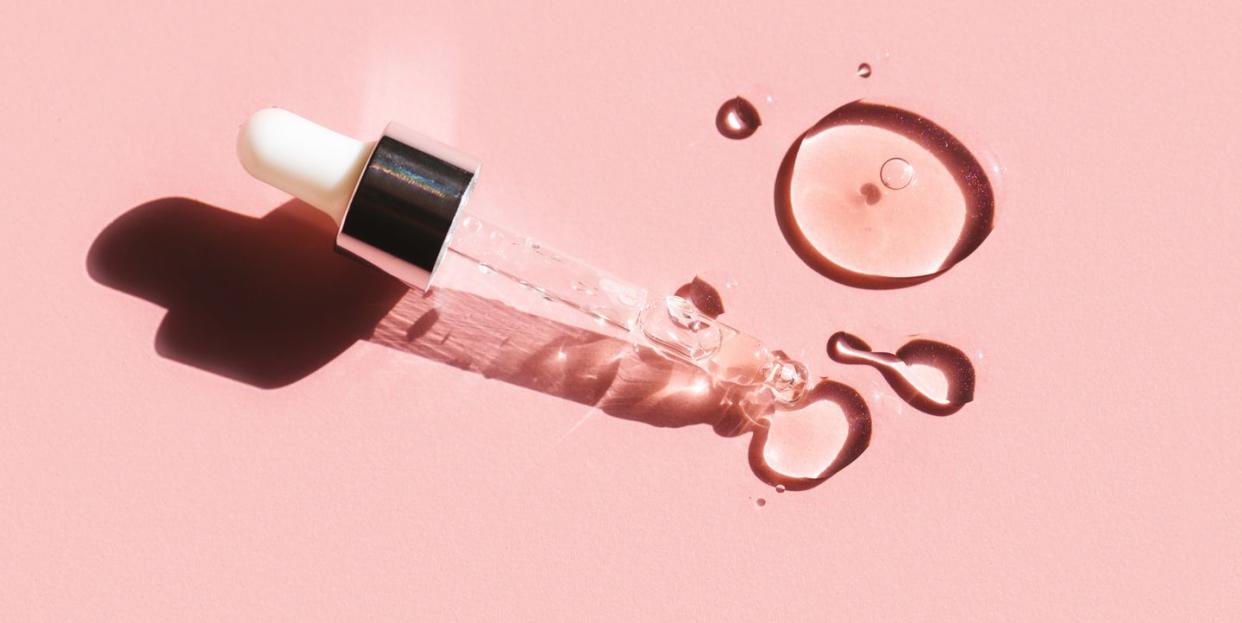If You've Got Sensitive Skin, Microdosing Might Be Your New BFF

"Hearst Magazines and Yahoo may earn commission or revenue on some items through the links below."
When you hear the word microdosing, what comes to mind?
If it's weed, that makes sense. It’s long been associated with the green stuff as a way for people to get some of the benefits of marijuana with less of a high via, as the name implies, a small dose.
But now, that same thinking is being applied to skincare. By microdosing your favorite active ingredients, you can supposedly max out the benefits of your formulas, like hydration and brightening, without the side effects of super-high concentrations, such as redness, dryness, and irritation.
“This approach can be quite powerful for some individuals,” says Anar Mikailov, MD, a dermatologist in Rochester, NY, and founder of Skintensive.
Below, the scoop on microdosing skincare and how to do it right.
Who should microdose skincare?
For starters, it can be great for those with capital-S sensitive skin. If you’ve ever dabbled in retinoid and ended up with a red, flaky face, for instance, microdosing is worth keeping in mind.
Dr. Mikailov recommends the microdosing strategy to anyone who’s developed a stinging or burning sensation within 24 hours of applying a new active. (One major exception to that rule: “Those who develop true allergic reactions, such as itch and swelling or hives, should not use any dose,” he says.)
It can also be beneficial for those with mature skin, which tends to be dry and more fragile, and is worth considering for anyone “who just wants to dip a toe into the world of skincare actives,” says Mona Gohara, MD, a dermatologist in New Haven, CT. “Sometimes, a little goes a long way in terms of an initial adjustment and comfort level.”
What skincare products should be microdosed?
“We often recommend this with prescription medicines and, in many cases, find great outcomes,” says Dr. Mikailov. But even when you’re working with OTC formulas, it still could be a win. “In non-prescription skincare, some ingredients can be challenging to tolerate at full doses, but at lower frequent doses, the side effects ameliorate while benefits persist,” he says.
You could try it with any ingredient that triggers a change in your skin barrier, such as speeding up cell turnover or shedding dead cells. For instance, retinoids, vitamin C, and alpha and beta hydroxy acids are all good contenders, says Dr. Gohara. “Often there is a ramp-up period that is required for these, and some patients cannot tolerate them,” she says. “Microdosing is a good alternative.”
“Anything that has the potential for irritation” is fair game, she adds. Meanwhile, ingredients like hyaluronic acid and ceramides actually strengthen the skin barrier, so there’s no need to microdose these.
How do you microdose your skincare?
First of all, talk to your dermatologist if you've had reactions to certain ingredients in the past, or are just uncertain whether this trend is for you.
Then, look for products with lower concentrations of active ingredients, Dr. Mikailov says. Usually, you can find that on the packaging: Look for a product with 8% glycolic acid, for example, as opposed to the double-digit dosages in some formulas. A product with 0.1% retinoid would be considered a micro-dose compared to a typical .25 to 1% formula. If that’s not feasible, you can also just use less of a product—so, scale back from a pea-size amount of product to just a pinprick’s worth.
Next, incorporate one active ingredient into your beauty routine at a time. “Use a gentle cleanser, then microdose one product, then moisturize,” says Dr. Gohara. (So, either use a product with lower concentration or a smaller amount than the package instructions.) “For example, at night, wash, add in the dose of retinoid, then moisturize.”
Whatever you’re using, do this just once a week to start, adding an extra day only if your skin is reacting well. (Again: Call your derm or primary care doc if you have any concerns or issues.)
“Once you get to maximum frequency without irritation, you can add in another product,” she says. “Remember that this is usually used in the context of sensitive skin, so small amounts and a gradual increase in the frequency of use is important.”
Are there other ways this trend is manifesting?
The microdosing approach is also being applied to injectables, like hyaluronic-acid fillers and neuromodulators. But it’s a little different. “Microdosing is often done as a strategy when deciding how to achieve a certain outcome,” Dr. Mikailov explains. “An injector will use less units of the filler or neuromodulator in this case, not a lower concentration.”
It’s similar, though, in its less-is-more mindset. The idea is to use small amounts to soften but not completely remove the lines, says Dr. Gohara. Instead of trying to minimize irritation (which usually isn’t an issue with injectables unless you have an allergy, which is a much bigger concern and makes them off-limits entirely) the goal is to retain a natural, still-you-but-well-rested look.
Bottom line: Microdosing skincare could be worth a shot whether you’re skincare-curious, dealing with persistent redness, or dipping a toe into injectables.
You Might Also Like

